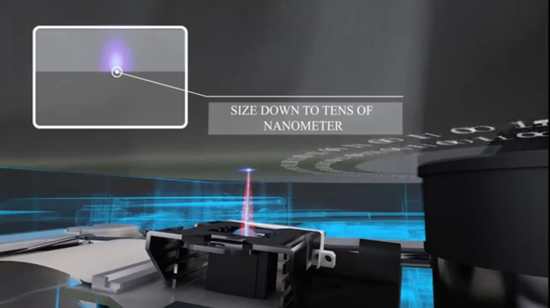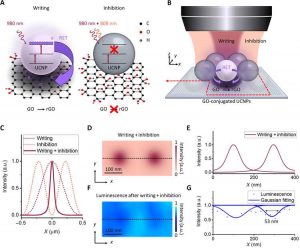R&D: Sub-Diffraction Optical Writing Information Bits, Towards High-Capacity Optical Disk
700TB on 12-cm disk by researchers at University of Shanghai for Science and Technology, RMIT University, and National University of Singapore
This is a Press Release edited by StorageNewsletter.com on March 12, 2021 at 2:16 pmBy Zhang Liu
The total amount of data generated worldwide is expected to reach 175ZB by 2025.
If 175ZB were stored on Blu-ray disks, the disk stack would be 23x the distance to the Moon. They face the urgent need to develop storage technologies that can accommodate this amount of data.
The demand to store ever-increasing volumes of information has resulted in the widespread implementation of data centers for big data. These centers consume massive amounts of energy (about 3% of global electricity supply) and rely on magnetization-based HDDs with limited storage capacity (up to 2TB per disk) and lifespan (up to 3-5 years). Laser-enabled optical data storage is a promising and cost-effective alternative for meeting this demand. However, the diffractive nature of light has limited the size of the information bits that can be reached and, as a result, the storage capacity of the optical disks.
Researchers at USST (University of Shanghai for Science and Technology), RMIT University and NUS (National University of Singapore) have now overcome this limitation by using earth-rich lanthanide-doped upconversion nanoparticles and graphene oxide flakes. This unique material platform enables low-power optical writing nanoscale information bits (nanoscale refers to sizes of 1-100 nanometers, where one nanometer is one billionth of a meter).
A much-improved data density can be achieved for an estimated storage capacity of 700TB on a 12-cm optical disk, comparable to a storage capacity of 28,000 Blu-ray disks. Furthermore, the technology uses inexpensive continuous-wave lasers, reducing operating costs compared to traditional optical writing techniques using expensive and bulky pulsed lasers.
This technology also offers the potential for optical lithography of nanostructures in carbon based chips that are highly required in next-generation nanophotonic devices.
Impact
Optical data storage has advanced over the last decades, but the optical disk storage capacity is still limited to a few terabytes.
The developed sub-diffraction optical writing technology can produce an optical disk with the largest storage capacity of all available optical devices.
While advances are needed to optimize the technology, the results open new avenues to address the global challenge of data storage. The technology is suited to the mass production of optical disks, so that the potential is enormous.
This technology could offer a cheaper and sustainable solution for the next genn of high-capacity optical data storage while enabling the energy-efficient nanofabrication of flexible graphene based electronics.
How it works
The technology uses a new nanocomposite material that combines graphene oxide flakes with upconversion nanoparticles.
Graphene oxide can be seen as a single layer of graphite with different oxygen groups. Reducing graphene oxide by eliminating these oxygen groups produces a material called reduced graphene oxide, which has similar properties to graphene.
Sub-diffraction information bits have been written in the nanocomposite using upconversion nanoparticles to reduce graphene oxide locally upon engineered illumination. The reduction of graphene oxide was induced by high-energy quanta generated in the excited upconversion nanoparticles through a process of resonance energy transfer.
The researchers chose upconversion nanoparticles because they enable efficient sub-diffraction optical writing using low laser beam intensity, resulting in low energy consumption and long lifetime of optical devices.
Team
The research was led by Distinguished Professor Min Gu , Centre for Artificial-Intelligence Nanophotonics, USST and RMIT University, in collaboration with Professor Xiaogang Liu, Department of Chemistry, NUS and the N.1 Institute for Health, NUS. The experimental work was led by Dr Simone Lamon, Postdoctoral Research Fellow, USST School of Optical-Electrical and Computer Engineering and RMIT School of Science.
Article: Nanoscale optical writing through upconversion resonance energy transfer
Science Advances has published an article written by S. Lamon, Centre for Artificial-Intelligence Nanophotonics, School of Optical-Electrical and Computer Engineering, University of Shanghai for Science and Technology, Shanghai 200093, China, and Laboratory of Artificial-Intelligence Nanophotonics, School of Science, RMIT University, Melbourne 3001, Australia, Y. Wu, Department of Chemistry, National University of Singapore, Singapore 117543, Singapore, Q. Zhang, Centre for Artificial-Intelligence Nanophotonics, School of Optical-Electrical and Computer Engineering, University of Shanghai for Science and Technology, Shanghai 200093, China, X. Liu, Department of Chemistry, National University of Singapore, Singapore 117543, Singapore, and The N.1 Institute for Health, National University of Singapore, Singapore 117456, Singapore, and M. Gu, Centre for Artificial-Intelligence Nanophotonics, School of Optical-Electrical and Computer Engineering, University of Shanghai for Science and Technology, Shanghai 200093, China, and Laboratory of Artificial-Intelligence Nanophotonics, School of Science, RMIT University, Melbourne 3001, Australia.
Fig. 1 Principle of nanoscale RETA optical writing on a GO-conjugated UCNP nanocomposite.
(A) The writing beam induces GO reduction through RET of high-energy quanta from UCNPs, while the inhibition beam inhibits GO reduction through suppression of high-energy quantum generation in UCNPs. (B) The experimental setup of a dual-beam super-resolution configuration that enables writing of subdiffraction features on the nanocomposite. (C) Simulated intensity distribution of the 980-nm writing beam with a Gaussian shape (writing), the 808-nm inhibition beam with a doughnut shape (inhibition), and their spatial overlap (writing + inhibition) along the radial direction in the focal plane. (D) Simulated intensity distribution on the nanocomposite irradiated with the dual-beam super-resolution configuration (writing + inhibition) with a writing beam intensity of 0.13 MW cm−2 and an inhibition beam intensity of 11.25 MW cm−2. (E) Simulated intensity profile along the dashed line in (D). (F) The 450-nm upconversion luminescence emission intensity from the nanocomposite after irradiation with the dual-beam super-resolution configuration (writing + inhibition). (G) Intensity profile along the dashed line in (F). a.u., arbitrary units.
Abstract: “Nanoscale optical writing using far-field super-resolution methods provides an unprecedented approach for high-capacity data storage. However, current nanoscale optical writing methods typically rely on photoinitiation and photoinhibition with high beam intensity, high energy consumption, and short device life span. We demonstrate a simple and broadly applicable method based on resonance energy transfer from lanthanide-doped upconversion nanoparticles to graphene oxide for nanoscale optical writing. The transfer of high-energy quanta from upconversion nanoparticles induces a localized chemical reduction in graphene oxide flakes for optical writing, with a lateral feature size of ~50 nm (1/20th of the wavelength) under an inhibition intensity of 11.25 MW cm−2. Upconversion resonance energy transfer may enable next-generation optical data storage with high capacity and low energy consumption, while offering a powerful tool for energy-efficient nanofabrication of flexible electronic devices.“
















 Subscribe to our free daily newsletter
Subscribe to our free daily newsletter


